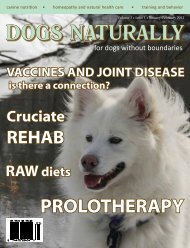July/August 2010 - Dogs Naturally Magazine
July/August 2010 - Dogs Naturally Magazine
July/August 2010 - Dogs Naturally Magazine
Create successful ePaper yourself
Turn your PDF publications into a flip-book with our unique Google optimized e-Paper software.
y a saner individual, more attuned to the real nutritional<br />
needs of the American people, as determined by the experts<br />
who knew what was best for us: the food manufacturers.<br />
This was Dr. Elmer Nelson, and in his words we get an idea<br />
of the change in philosophy that marked the transformation<br />
of the Bureau of Chemistry into the FDA:<br />
“It is wholly unscientific to state that a well-fed body is<br />
more able to resist disease than a poorly-fed body. My overall<br />
opinion is that there hasn’t been enough experimentation<br />
to prove that dietary deficiencies make one susceptible<br />
to disease.” - Elmer Nelson MD Washington Post 26 Oct 49<br />
Bernard Jensen illustrates how the tobacco industry and the<br />
food giants like Coke were indirectly behind the legal persecution<br />
of Royal Lee. Cigarette ads in the 40s and 50s<br />
showed medical doctors promoting the digestive benefits of<br />
smoking Camels. Or the advertising of Coke and other refined<br />
sugar foods stating that “science has shown how sugar<br />
can help keep your appetite and weight under control.”<br />
(Empty Harvest)<br />
During this same period, Royal Lee was kept in courts for<br />
years, fighting to keep the right to advertise his vitamin<br />
products, because he was a threat to the food manufacturers.<br />
Lee knew they were poisoning the American public. He<br />
proved that refined sugars and devitalized, bleached flours<br />
were destroying the arteries and the digestive system, causing<br />
heart disease and cancer.<br />
WHOLE VS. FRACTIONATED<br />
OK, natural vs. synthetic. Let’s start with Vitamin C. Most<br />
sources equate vitamin C with ascorbic acid, as though they<br />
were the same thing. They’re not. Ascorbic acid is an isolate,<br />
a fraction, a distillate of naturally occurring vitamin C. In<br />
addition to ascorbic acid, vitamin C must include rutin,<br />
bioflavonoids, Factor K, Factor J, Factor P, Tyrosinase,<br />
Ascorbinogen, and other components as shown in the figure<br />
below:<br />
_____________________A s c o r b i c A c i d______________________<br />
ascorbinogen<br />
bioflavonoids<br />
rutin<br />
tyrosinase<br />
Factor J<br />
Factor K<br />
Factor P<br />
__________________________________________________________________<br />
In addition, mineral co-factors must be available in proper<br />
amounts.<br />
If any of these parts are missing, there is no vitamin C, no<br />
vitamin activity. When some of them are present, the body<br />
will draw on its own stores to make up the differences, so<br />
that the whole vitamin may be present. Only then will vitamin<br />
activity take place, provided that all other conditions<br />
and co-factors are present. Ascorbic acid is described<br />
merely as the “antioxidant wrapper” portion of vitamin C;<br />
ascorbic acid protects the functional parts of the vitamin<br />
from rapid oxidation or breakdown.<br />
Over 90% of ascorbic acid in this country is manufactured<br />
at a facility in Nutley, New Jersey, owned by Hoffman-<br />
LaRoche, one of the world’s biggest drug manufacturers.<br />
Here ascorbic acid is made from a process involving cornstarch<br />
and volatile acids. Most U.S. vitamin companies then<br />
buy the bulk ascorbic acid from this single facility. After<br />
that, marketing takes over. Each company makes its own<br />
labels, its own claims, and its own formulations, each one<br />
claiming to have the superior form of vitamin C, even<br />
though it all came from the same place, and it’s really not<br />
vitamin C at all.<br />
FRACTIONATED = SYNTHETIC = CRYSTALLINE = FAKE<br />
The word synthetic means two things:<br />
– manmade<br />
– occurs nowhere in nature<br />
From the outset, it is crucial to understand the difference<br />
between vitamins and vitamin activity. The vitamin is the<br />
biochemical complex. Vitamin activity means the actual biological<br />
and cellular changes that take place when the stage<br />
is set for the vitamin complex to act.<br />
Think of it like gas and a car. Pumping the gas into the tank<br />
doesn’t necessarily mean the car is going anywhere. Other<br />
conditions and factors must be also present, in order for<br />
Activity to occur. The gas line to the carburetor must be<br />
clear, the carburetor jets must be set, there must be an exact<br />
mixture of air flow, the ignition must be turned on, the<br />
spark plugs must be clean, the exact amount of gas must<br />
reach each spark plug right before it fires, no gas must be<br />
left over in the cylinder after the plug fires. Getting the idea?<br />
If any of this stuff is missing, there’s no Activity: the car<br />
doesn’t run, or at least not very well.<br />
Amazing as it may sound if you’re hearing this for the first<br />
time, vitamins are more than the synthetic fractions we are<br />
commonly taught they are. The ascorbic acid you buy at the<br />
grocery store every few weeks, thinking you are buying<br />
Vitamin C, is just a chemical copy of naturally occurring<br />
ascorbic acid, which itself is still only a fraction of the actual<br />
Vitamin C. Real vitamin C is part of something living, and as<br />
such, can impart life. Your synthetic, fractionated chemical<br />
ascorbic acid never grew in the ground, never saw the light<br />
of day, never was alive or part of anything alive. It’s a<br />
chemical, a cornstarch derivative, a sulfuric acid byproduct.<br />
In your body it’s just another drug. Synthetic vitamins<br />
have toxic effects from mega-doses and actually can<br />
www.dogsnaturallymagazine.com <strong>July</strong>/<strong>August</strong> <strong>2010</strong> | 53












